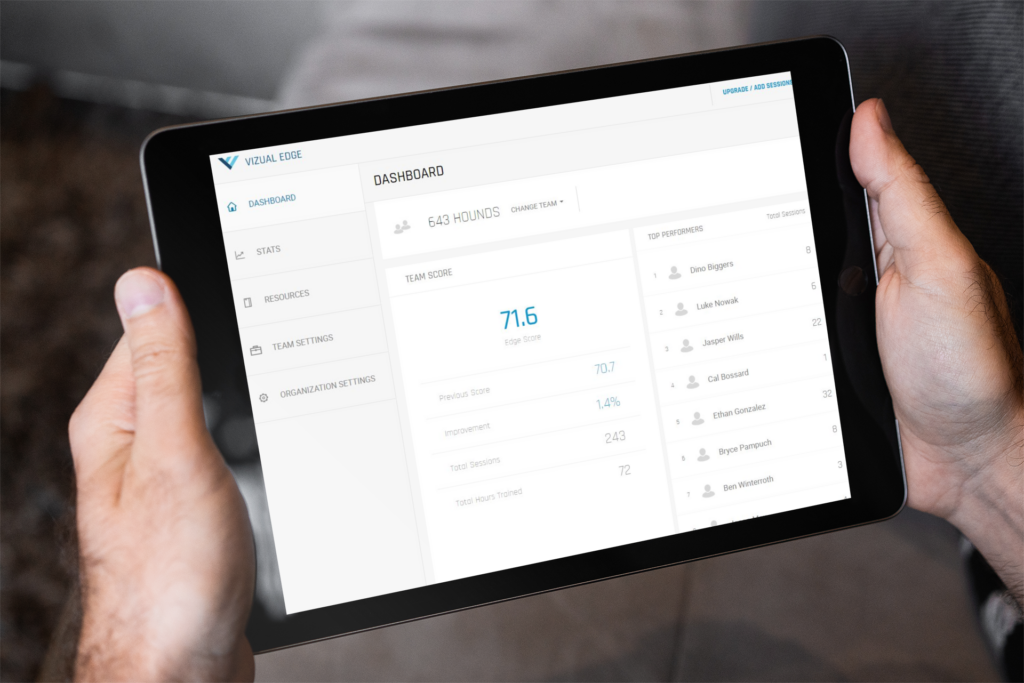
In the realm of athletics, vision extends far beyond the ability to see clearly. Your performance on the field, court, or rink isn't just about physical condition or technical skill—it's also about how effectively you process the rapid visual information that sports inevitably throw at you. This is where the Edge Score, a pioneering metric developed by Vizual Edge, comes into play. But what exactly does this score entail, and how can athletes and coaches use it to improve performance?
At its core, the Edge Score is a comprehensive score out of 100 that measures athlete's visual and cognitive abilities. Unlike a routine eye checkup that measures sight and acuity (20/20 acuity), Vizual Edge's assessment delves deeper, testing visual skills that are crucial for athletic success. These skills include alignment, depth perception, convergence, divergence, recognition, and tracking—all essential for interpreting and interacting with the dynamic environments of various sports.

The Edge Score has been a prominent metric in Major League Baseball for more than 20 years, helping clubs assess potential draft picks to ensure they have the visual processing skills required to play at the highest level in baseball. Vizual Edge has tested more than 30,000 prospects through partnerships with countless teams over the last two decades, and research shows that players who have higher Edge Scores, have a greater chance of making it to the MLB.
The Edge Score isn’t just a number; it's a gateway to tailored improvement. Here’s how it translates to better performance:
As an athlete, the importance of physical and technical training is clear, but the visual aspect often goes underappreciated. However, the visual information you process during a game is vast and complex, directly influencing your performance. This is where understanding your Edge Score becomes crucial.
Sports are filled with fast-moving objects and split-second decisions. Whether it's a baseball hurtling towards you at 90 mph, a tennis ball ricocheting off your opponent’s racket, or a soccer ball being passed between teammates, your ability to react quickly depends heavily on your visual processing skills. A higher Edge Score typically indicates better visual cognitive skills, which usually means faster and more accurate reactions in these critical moments.
Many sports outcomes hinge on rapid decision-making. With a comprehensive assessment through the Edge Test, you gain insights into your recognition and tracking abilities—how quickly and accurately can you interpret a play's development and track multiple players and objects? Enhancing these skills can lead to smarter, quicker decisions on the field, giving you a strategic advantage over competitors who may not be training their visual skills as intensely.
Skills like alignment and depth perception are crucial for accurately judging distances and aiming, essential for hitting a target, scoring a goal, or passing precisely to a teammate. Skills like convergence and divergence are highly valued in scouting reports and serve as significant data points that characterize a player's capability. A tailored training regimen, designed around your specific visual needs identified through your Edge Score, can enhance your performance in these critical areas.
Regularly measuring and training based on your Edge Score not only boosts your current performance but also sets a foundation for continued improvement throughout your sports career. It ensures that as the game speeds up with higher levels of play, your ability to process and respond to visual stimuli remains a step ahead, preventing plateaus in your development.
The Edge Score is a transformative tool for coaches who aim to optimize both individual and team performance in competitive sports. Here’s a detailed exploration of how coaches can use Edge Scores to their full potential:
The first step is to comprehensively understand the visual strengths and weaknesses of each player. Edge Scores provide a detailed breakdown of skills such as depth perception, tracking, and recognition. With this data, coaches can identify which athletes may benefit from specific types of visual training.
In essence, leveraging Edge Scores is not merely about enhancing individual player performance but about fostering a more visually adept, strategically sophisticated, and cohesive team. This holistic approach to coaching with an emphasis on visual skills can lead to significant gains in competitive advantage, making the most of what modern sports science offers to elevate athletic performance.
The Edge Score provided by Vizual Edge is more than a measure of visual acuity—it's a reflection of an athlete’s ability to effectively process and react to visual stimuli in high-pressure environments. By understanding and improving their Edge Score, athletes can unlock new levels of performance, making the most of their training hours and ultimately gaining a competitive edge in their sport.
With regular use of the Edge Trainer and continuous monitoring of their Edge Score, athletes can not only enhance their current performance but also set the stage for longer-term success in their sporting careers. Coaches and players alike, embrace the visual aspect of your training and watch as your game reaches new, unprecedented heights. Find out what your Edge Score is and get started with your own Vizual Edge account today at vizualedge.com/signup. #FindYourEdge